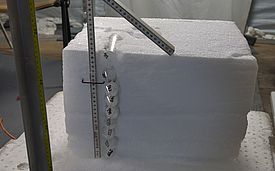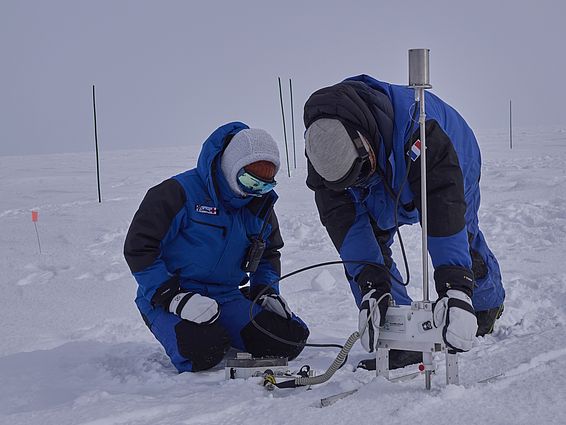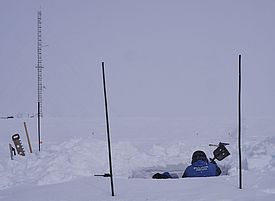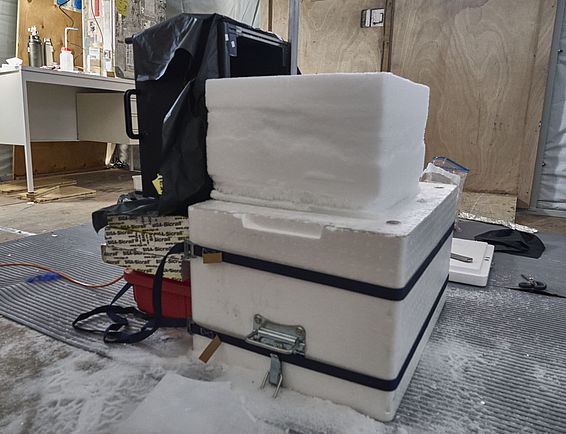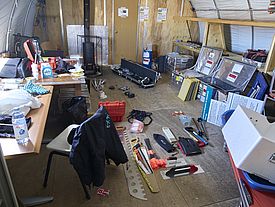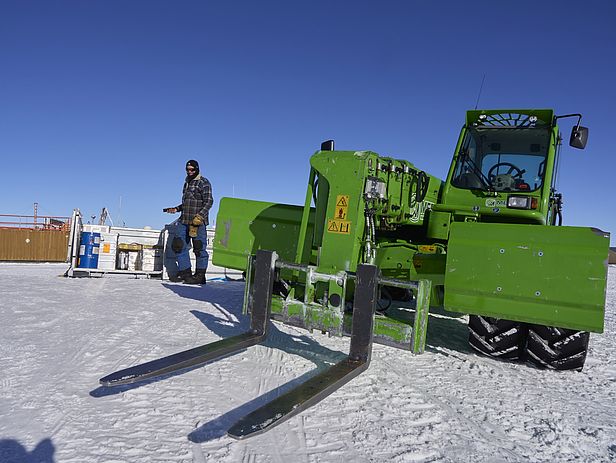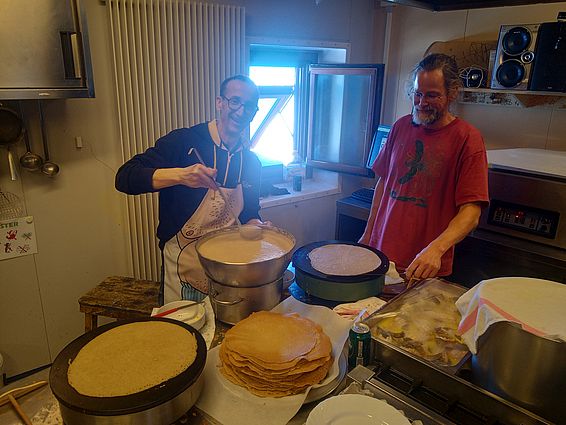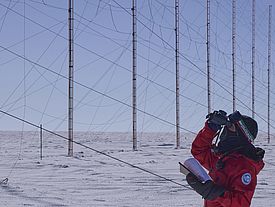21.02.2024 | Matthias Jaggi | SLF News
SLF technician Matthias Jaggi reports on his expedition to the Antarctic. Part four: last experiments, packing - and crêpes for 52 people
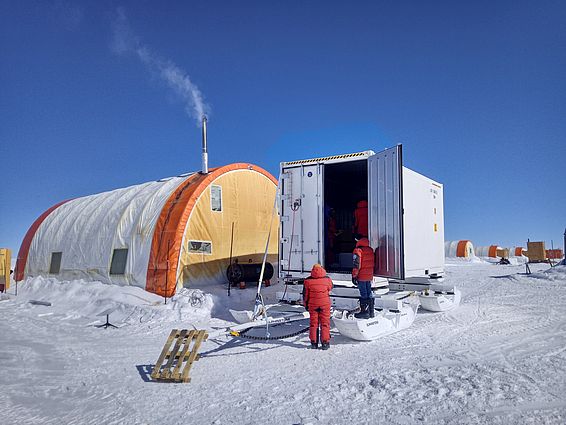
Unfortunately, the time is passing far too quickly. I already have to start finalising my work at the beginning of the third week of January. In our project application to the French Polar Institute Paul-Émile Victor (IPEV), we asked for the longest possible stay in order to maximise the duration of the experiment, but the fact that (as of recently) the handover of the Dome C research station to the winter crew now takes place one to two weeks earlier wasn't entirely clear. All in all, I had a successful and early start to the experiment, but now I have to dismantle it almost ten days earlier than six years ago, which, though not quite ideal, is still better than nothing. The deadline is Friday 19 January. That's when the third and final traverse from Dumont d'Urville will arrive. Once all the supplies have been unloaded, research material and samples that need to be returned to Europe will be loaded up. According to my planning, I need five days to dig the last snow profile, cut out and measure my snow blocks, seal the remaining snow samples and pack up my kit in my aluminium boxes.
Final experiments ¶
I plan everything meticulously so that I can stick to the schedule. This means that I no longer have any leeway to bring forward or postpone work due to unfavourable weather. And as Murphy's law would have it, I have to dig my last profile on what is most definitely the worst day of the summer. For the first time, the sky is completely overcast, there's a fierce wind and it's even snowing a bit (normally it takes a lot of imagination to even recognise precipitation, the so-called diamond dust).
What a win for me, eh? However, I am lucky enough to have some help. As I had been working alone in the snow profile 75% of the time, for safety reasons I had to report to the station by radio every half hour. And everyone with a radio, so basically everyone, heard my half-hourly announcements. My name, my voice, my English - all of that must have been etched in their minds. And many people will no doubt have wondered "what's this guy actually doing out there in the 'forbidden zone' every day?" So I kept getting offers from people wanting to help out, which I then, because I'm such a nice person, accepted on the day the weather was terrible. This meant the last snow profile was also completed very quickly. I transported the snow blocks from the -50 °C EPICA storage facility to the Spacca Ossa tent (see part one of my Antarctic blog) for sampling.
There is definitely a difference between working at -50 °C and working at only -15 °C. I am a little tense as I unwrap the four blocks from the foil. This has to go perfectly. The blocks are large enough to take a 'dirty' sample a second time, but there's not enough for more. First of all, the edges are cut away from the block because we don't want samples from areas possibly affected by edge effects. The heating plates of my metamorphism boxes heated evenly over the entire surface and the insulation panels around the block provided for good insulation, but there are still heat losses towards the edge and so the conditions there differ slightly from what you're aiming for.
Once again, I also use the SnowImager, among other things, to determine the snow microstructure. However, because this is designed for measurements in the snow profile, I have to improvise a little with the block. The key thing is that everything around it must be in as much shadow as possible and the entire height of the block must be in the camera's field of view. I can make do with a polystyrene box as a platform, a stick-on gauge, a few clamping sets and a large black cloth. I sample all the blocks for snow microstructure and O-18 isotopes. I won't know how either variable has changed for another six months or so. The isotope samples are analysed by our partner in France, and I'll analyse the snow samples for microstructure myself using the CT scanner in Davos.
Packing ¶
And as always, you underestimate how much tidying and packing is involved. Already slightly exhausted, I set about my last task. I lay out all the equipment next to the boxes so that it can dry and I can see whether everything is there. It looks a bit like my childhood bedroom 30 years ago. It's a huge mess, you're forced to tidy up and don't really feel like it. In this case, however, I'm doing it voluntarily so I'm smiling. At the last minute, I stick the final address label on the box while my colleagues from logistics take away the first boxes. It's a relief to know that the work is done, but also a little frustrating that I can't use the remaining time to work on the experiment.
Crêpes for 52 people ¶
I spend the last few days before my departure from Concordia trying to make myself useful somehow. One day I help lay cables and install power sockets, on another I and three others make crêpes for the remaining 52 station residents, and I help the overwintering glaciologist with snow profiling. There's always something to do at a station like this, so boredom would be a poor excuse. It also makes sense for me personally to give myself a rough daily structure to ease the 'post-expedition depression' somewhat. You're tired, your work is done, you're planning to go home and the return journey dates change from day to day. None of these factors help lift the mood.
Flights very much depend on the wind and visibility on the coast and on the high plateau. For example, we might have clear blue skies at Dome C but very strong katabatic winds on the coast, so a flight would be cancelled. The window of good weather needs to be long enough at both ends in order for the flight to go ahead. There are three return trips scheduled this season. From Concordia, you first have to fly to the coast, which takes around four hours. You then take the French supply ship L'Astrolabe from Dumont d'Urville to Mario Zucchelli Station, from where you fly back to New Zealand via the US station McMurdo and, in my case, back to Hobart, Tasmania via Australia's Casey Station. It wasn't planned but it turned out that this flight to Casey was the last one. The station manager and technical manager had already left the station so we left the ship after the captain, so to speak. Despite the almost overwhelming desire to go home, I am overcome with tears as the pilot slowly but steadily accelerates the Basler. The 13 waving overwinterers and Concordia Station get smaller and smaller. A chapter has come to an end.
Already published: ¶
- Part 1: the arrival
- Part 2: free at last!
- Part 3: daily and penal labour
